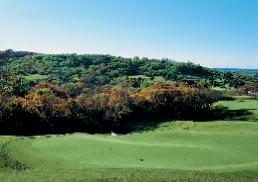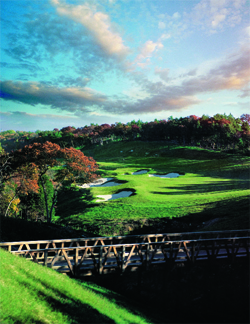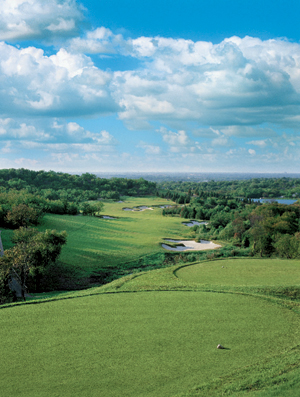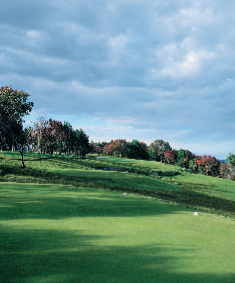Tom Fazio declares if Dallas National were the only course he ever designed, he would have had a great career. Dallas National is purely golf. You will not find a home, hotel, swimming pool or tennis court on any hole. The only place adjacent to the property is a secluded convent that chimes its bells every once in a while. The nuns played a primitive role during the construction process.
“We asked the nuns to pray for rain. They prayed and it rained,” John MacDonald, developer and founder, says.
The extraordinary part of Dallas National Golf Club lies in its heart – MacDonald. It was he who envisioned Dallas National and brought it to fruition through a lifetime of hard work. As a rater for Golf Digest, he has seen and played the best.
 “My goal was to create something extremely special for Dallas and to create a Top 100 course,” MacDonald says.
“My goal was to create something extremely special for Dallas and to create a Top 100 course,” MacDonald says.
Discussing the history and design of Dallas National, in the 12,000 square-foot-clubhouse, MacDonald explains he wanted to bring Dallas back to the national spotlight in the golf world by creating a top-tier, unmatched golf course inside the city limits. In fact, there had not been a new course built within the city limits since Royal Oaks Country Club in 1969. The terrain in the city had been forgotten.
MacDonald found the property he wanted only six miles southwest of downtown Dallas. Many dissenting voices questioned the land’s location in a challenging economic area often disgracefully dismissed as a tough, minority-dominated part of town. MacDonald says the people he meets in the area are “hard-working family people.”
“Over time, the impact that Dallas National will have on southwest, Dallas will be phenomenal,” MacDonald says of the club.
As he pressed forward with the re-zoning process, a daunting task, MacDonald heard all the rumblings from those who doubted members would pay the $100,000 Founding Member initiation fee for a golf club on the south side of the Trinity River. MacDonald heard them, but he didn’t listen. The land is possibly the most beautiful 388 acres in the entire city and offers views many thought only possible in the Texas Hill Country. He needed an architect who could take this exquisite slice of earth and transform it into a masterpiece.
There was only one person: Tom Fazio.
“Tom was my first and only choice because he has worked with many different types of sites,” MacDonald says. “Now, after working with Tom, I would never consider another architect.”
 The course appears natural even though there was a sizeable amount of earth moved. There is a 200-foot elevation drop throughout the course, yet only one hole appears to play uphill. A course in which there are three plateaus and two canyons never requiring more than a half-club increase on any iron shot has to be a gem. This design trait is one that should be applauded.
The course appears natural even though there was a sizeable amount of earth moved. There is a 200-foot elevation drop throughout the course, yet only one hole appears to play uphill. A course in which there are three plateaus and two canyons never requiring more than a half-club increase on any iron shot has to be a gem. This design trait is one that should be applauded.
The short game practice area, with seven bent grass greens, allows players to accurately discover how their irons are going to react. They may practice everything from greenside bunker shots to 150-yard iron shots. A leisure walk from the short game practice area leads to a superior practice green. The speed of the bent grass practice greens is consistent with actual course conditions.
Dallas National is an unparalleled test of golf, a par 72 playing over 7,300 yards from the back tees. There are five sets of tees to challenge players of all skill levels.
“We only get 10 percent of play from the Texas back tees,” David Denley, Dallas National club manager, says.
More importantly, playing a forward tee does not unjustly alter the integrity of the holes. The spirit, intent and challenge of each hole still exists, which is a rarity in itself these days and another testament to Fazio’s brilliance.
Dallas National is a shot maker’s course. Each hole is unique and provides its own story. The fairways are generous, but players should use the green to tee approach to plan their shots. Due to the undulating fairways, players will undoubtedly face their share of uneven lies. High premium is placed on local knowledge. “Feel” players will excel in this environment while mechanical players must trust their forecaddie.
Forecaddies are available and required for groups larger than two. The well-informed caddies have an incredible ability to bring you into the game and are diligent in their manner. While you may choose to move through your round at a leisurely pace, the caddies are always at the ready with all the information you need to execute the next shot.
There is ample opportunit y for big hitters. The par-fives, hole numbers two, four, 10 and 18 offer birdie or better scoring opportunities. However, you cannot bully this course. The secondary rough is substantial. Better players will play back to the fairway to avoid big numbers.
y for big hitters. The par-fives, hole numbers two, four, 10 and 18 offer birdie or better scoring opportunities. However, you cannot bully this course. The secondary rough is substantial. Better players will play back to the fairway to avoid big numbers.
The best view on the course comes from the elevated tee box at hole 10. When playing this par five, one cannot help but feel as if on top of the world. Alluring white bunkers frame this majestic setting.
The collection of par threes offer a variety in distance and cosmetic appeal. The best scoring opportunity on a par-three comes on the 172-yard hole 13. It plays short and to the point. The most beautiful par-three is hole five. Playing 234 yards from the back, it fills the eye with a panoramic splendor. A bridge crosses over a gorge to a large, angled green. Avoid hitting it short and left.
A brief respite after hole five brings golfers to a divine, self-serve courtesy station. The elegant interior is comfortable and stocked with imported beers and gourmet snacks. Gathering strength and nourishment at the courtesy station is important because a challenge ensues.
Uniquely positioned, there are four par-fours in a row, which finish the front nine. The par-fours are some of the best you will ever play.
Beginning with the monster, 458-yard number six, which requires a demanding lengthy tee shot and a tough approach shot to a slightly elevated green, the round crescendos to what may be one of the best holes on the course – hole nine. This hole, a true Fazio test, requires another big drive. Bunkers guard the way both from the tee and approach shots. Try to avoid bringing the back of the green into play.
On hole 11, you will find the most challenging green. An approach shot to the wrong area of the green will most likely ensure a three-putt.
Trees line most of the fairways and block out all sound from what are understood to be adjacent streets and thoroughfares. Th e presence of so much greenery softens the Texas heat.
e presence of so much greenery softens the Texas heat.
There are no tee times, as Dallas National is a “golf on demand” environment for its members. With local memberships sold-out, a waiting list is being established.
In May 2005, Dallas National was ranked No. 65 in the United States and No. 1 in Texas by Golf Digest. That stellar achievement is made all the more impressive by the fact the course opened on Labor Day 2002. The course, though extremely mature when it opened, continues to develop as nature adds to the working definition of perfection. Dallas National will undoubtedly go up in the national rankings with years to come.
History takes time to build, and it is all Dallas National needs to take a top spot.
On the Links has had an ongoing policy of not rating courses, but if we did, Dallas National would receive the highest of marks. We are comfortable and confident referring to it as hallowed ground.
For more information on Dallas National Golf Club, visit www.dallasnationalgolfclub.com.